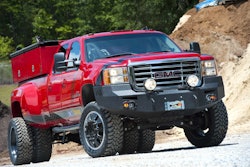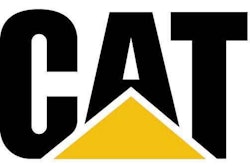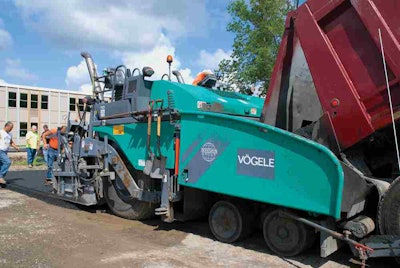 Vögele, whose Vision 5203-2 paver is seen here, recommends an unequal-width front-mount screed, with extensions.
Vögele, whose Vision 5203-2 paver is seen here, recommends an unequal-width front-mount screed, with extensions.Just imagine that it’s a sunny spring morning in suburban America, and that our job is to pave and compact the asphalt for a large Walmart parking lot. We posed just that task to seven equipment manufacturers and asked them what pavers and rollers they would choose, and the reasons for their selections.
Today, we’ll deal with the pavers. Tomorrow we’ll continue in a separate post with the rollers, so be sure to check back. (Part 2 has been posted. Click here to read it.)
This hypothetical parking lot is 250,000 square feet in size, with some islands, landscaping and decorative pavers. The project will require 3,500 to 4,000 tons of dense-graded asphalt that we’ll pave at 3 inches thick. The base is complete, and consists of 6 inches of aggregate base course. The job should be paved with average speed, and the asphalt leaves the plant at 300 to 325 degrees F.
“Paver size isn’t critical on a job this large,” said Todd Mansell, training consultant, Caterpillar Paving Products. “Either a 10-foot or an 8-foot paver can do the work. The smaller paver can maneuver into tighter spaces better, but the larger paver has more hopper size. A tracked paver would be best due to traction, mobility, maneuverability and speed. Smooth faced rubber tracks are preferable to tread faced because they will not disturb the base as much when maneuvering.”
Screed choice is a personal preference, Mansell said. A rear-mounted screed is sufficient but care is needed if there is a lot of width adjustment. Front-mounted extender screeds are better at on-the-move width adjustment, but you have to watch to make sure the extensions are maintaining a proper head of material.
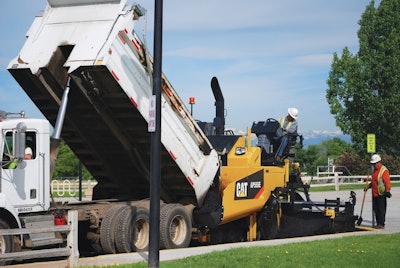 Cat’s 8-foot AP55E paver has a large capacity hopper.
Cat’s 8-foot AP55E paver has a large capacity hopper.“We would choose our Cat AP555E paver with an AS2252C Vers-A-Mat screed,” Mansell said. “It is an 8-foot paver, but it has a large capacity hopper, so you get the extra maneuverability and compact size of the small paver, but you don’t sacrifice much for capacity.”
He said the paver is quite powerful for its size as well, so there would be no issues with wider pulls or pushing trucks. The machine’s screed has front-mounted extenders and lays a smooth mat, whether width adjustment is needed or not. Mansell recommends running Cat Grade & Slope automation on the paver to control mat thickness and grade/slope. He would use one sonic sensor on each side of the paver.
The case for a rubber-tired paver
“For this job, any of our 8-foot or 10-foot pavers are appropriate, but with the stone subgrade, a rubber-tired paver would be a good choice,” says Laikram “Nars” Narsingh, manager, Vögele commercial support and development, Wirtgen America. “That will keep the paver tracks from tearing up the base. A 10-foot Vögele Vision 5203-2 or an 8-foot 5103-2 wheeled paver would be appropriate.”
But the equipment choice also depends on the main business of the contractor. “If the contractor does smaller parking lots, residential streets and driveways primarily, the 5103-2 will be the better choice,” Narsingh says. “If the contractor does mostly main line paving in addition to larger parking lots, the 5203-2 will be best.”
The type of screed mounted on the tractor is important, Narsingh says. “The screed will have to move in and out constantly for a job with lots of obstructions – such as islands and other obstructions within the parking area,” he says. “Such a screed will be an unequal-width front-mount screed, with extensions.”
“Unequal,” Narsingh says, refers to the extension’s front-to-back dimension of 8 to 12 inches versus the main screed’s front-to-back dimension of 24 to 28 inches, depending on the manufacturer. “The unequal-width screed is more versatile, as there is no pre-strikeoff to trap mix between the extensions,” he adds. “And they have short end gates, minimizing hand work while providing the ability to extend the retract without trapping mix. You can get right up to your obstruction, whatever it is, be it an island or a storm sewer inlet.”
The most versatile paver is the wheeled tractor with front-mount screed, Narsingh says, but you also could use a tracked paver with a front-mounted screed, or any paver with a rear-mounted screed. “The objectives of parking lot paving are versatility of equipment and mat quality,” he says. “The unequal length front-mount screed will definitely give you the versatility.”
Consider heated end gates…
 One solution: The Roadtec RP 170 with a Carlson EZ Screed equipped with heated end gates.
One solution: The Roadtec RP 170 with a Carlson EZ Screed equipped with heated end gates.If the grade is solid and doesn’t slope much, then a Roadtec RP-170 with a Carlson EZ Screed equipped with heated end gates is ideal for the project, says Kyle Hammon, Roadtec’s technical marketing coordinator. That is an 8-foot rubber tire paver with a front extendable screed.
If the grade is steeper or less stable, then a rubber track paver such as the RP-175 would be recommended. Topography should always factor into your choice of equipment. The 8-foot paver is a great choice when considering in the number of islands and obstacles. The heated end gates on the screed will improve the longitudinal joint quality of the mat.
If you changed the choice of machines to a 10-foot track machine you could achieve higher production with fewer joints, says Hammon. This change brings forth a different set of considerations. The 10-foot track machine would allow for passes 14 feet and wider but one extra roller would be necessary. Ten-foot machines, such as the RP-190 and RP-195, will also require more asphalt. If the asphalt isn’t arriving on the jobsite to meet the demand of a 10-foot paver, then cold joints become an issue.
…and plant production
It’s important to factor in the plant’s production capacity for the day and the job, Hammon says. If the plant is close and can produce plenty of asphalt for the job, it may only take two days to pave the parking lot. That would be using tandem-axle dumps to haul asphalt for an 8-foot paver versus using tri-axles or tractor trailers when longer distances are considered.
To eliminate the variable of truck travel time, consider using a Roadtec Shuttle Buggy SB-1500, which assists with keeping the asphalt uniform in temperature for better compaction and better overall appearance of the mat. This machine would be best for the finished product.
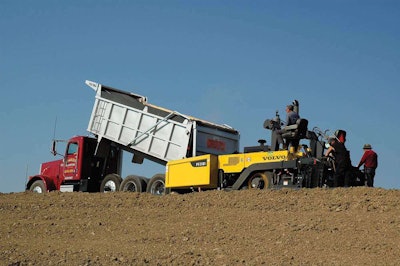 The Volvo PF2181 has an 8-foot screed, which transports with no permit, compared to 10-foot units.
The Volvo PF2181 has an 8-foot screed, which transports with no permit, compared to 10-foot units.Smaller jobs generally use smaller dump trucks, where larger road jobs have higher capacity trucks, says John Mooney, paver and milling product manager, Volvo Construction Equipment. Generally, a road job is set up to pave around 35 to 60 feet per hour at a width of 12 to 14 feet. Parking lots are laid out for the longest run, between edge and island. The goal is to minimize the number of passes, but they will generally be 10 to 12 feet wide, Mooney says.
Generally speaking, the paver will run at a speed matching the delivery speed of the asphalt, Mooney says. If you figure 20 tons of material at 3 inches thick and 12 feet wide, that is roughly 90 feet of travel. At 30 feet per minute, it takes three minutes to pave a truck-load. Plus, you have 10 tons in the paver, which gives the crew just short of five minutes to cycle the truck.
Mooney says he would prefer to use the Volvo PF2181 rubber-tired asphalt paver for this job. The paver has good maneuverability with pivot steering and a tight turning radius. Plus the tires will disturb less surface area than a tracked unit like the Volvo PF4410. The PF2181 has an 8-foot screed, which transports with no permit, compared to 10-foot units. And, Mooney says, the PF2181 features good visibility, which is important on the parking lot. You’ll need to pave closely to islands and landscaping.
Click here to read Part 2 in this series and find out what rollers the manufacturers suggested.




